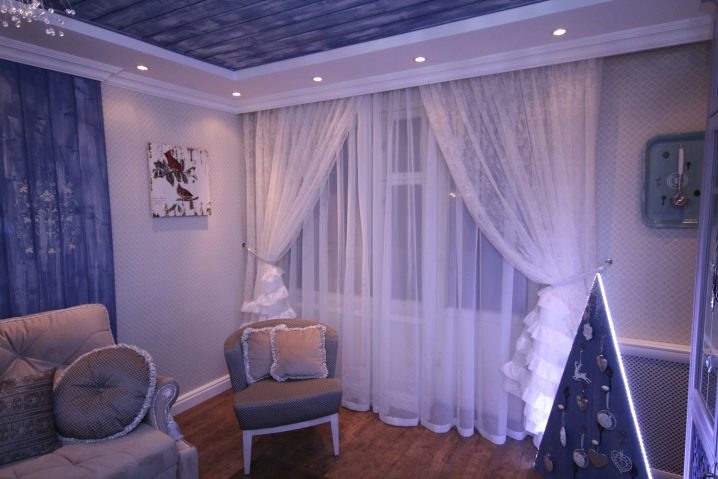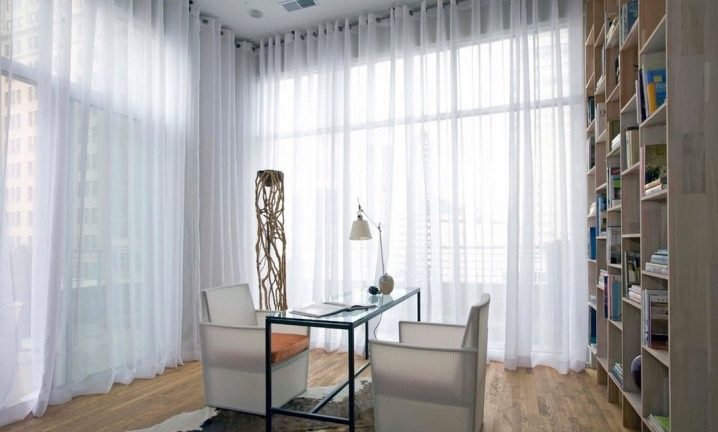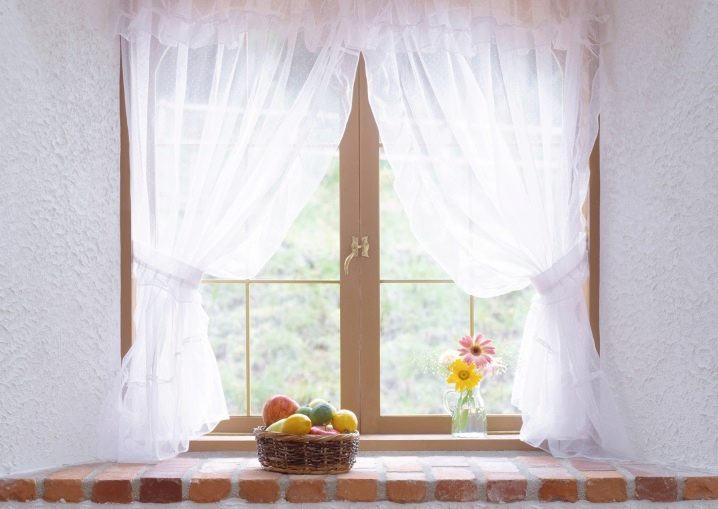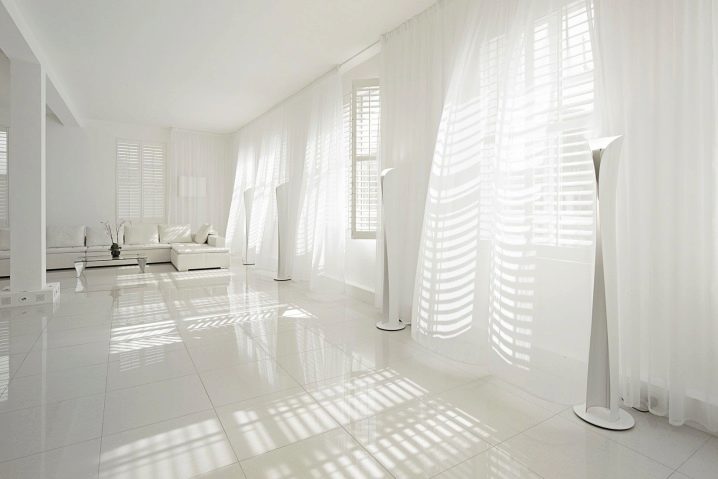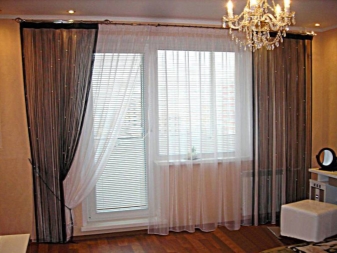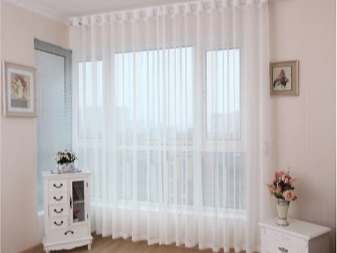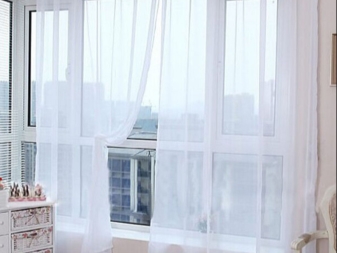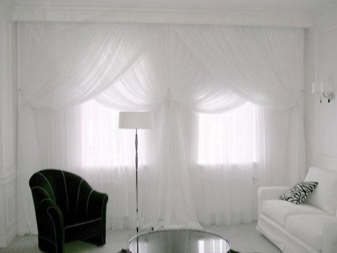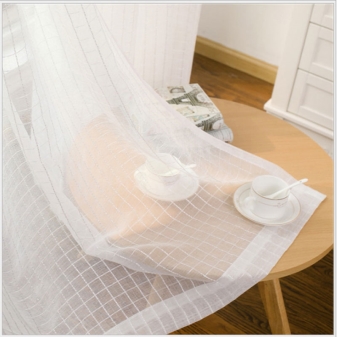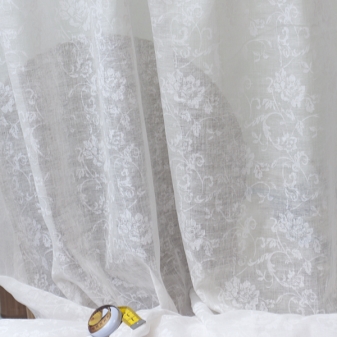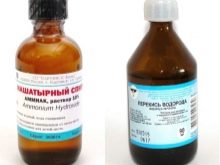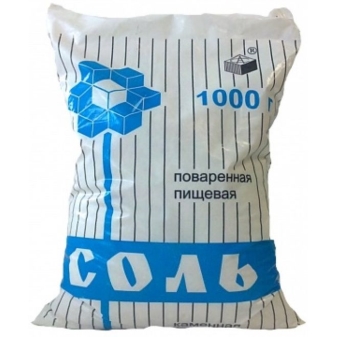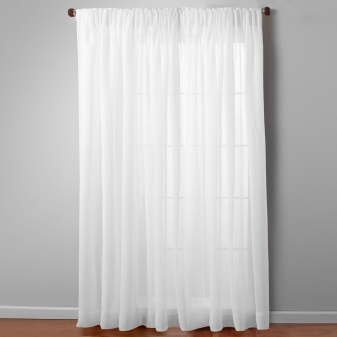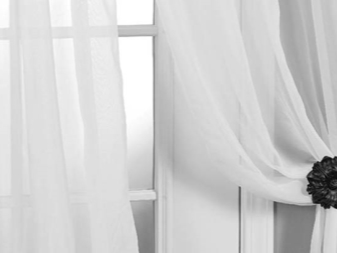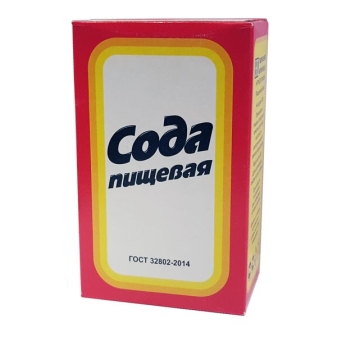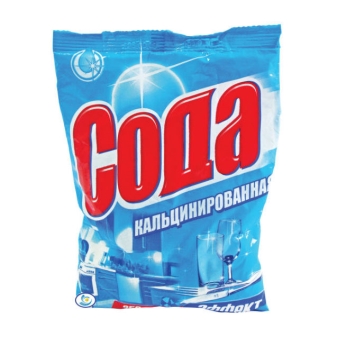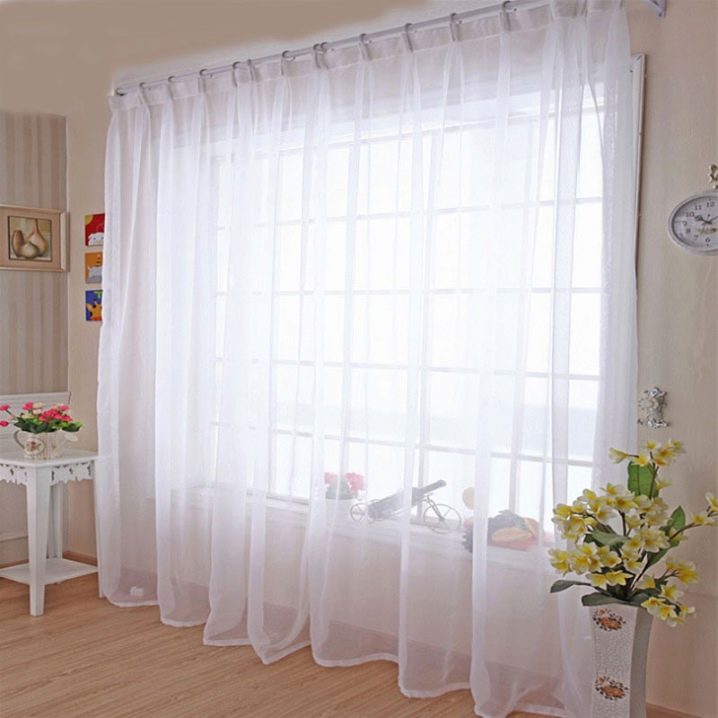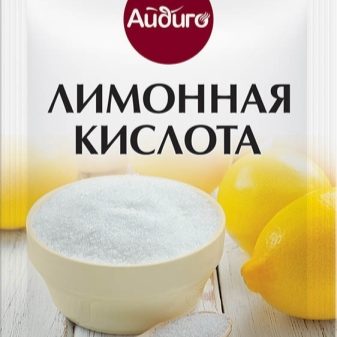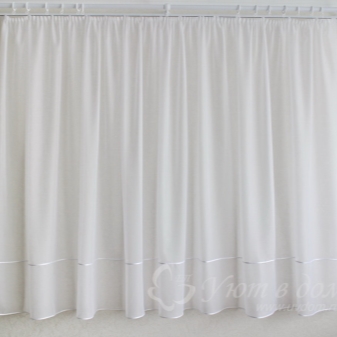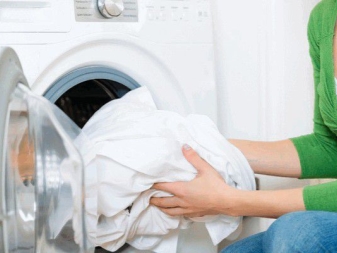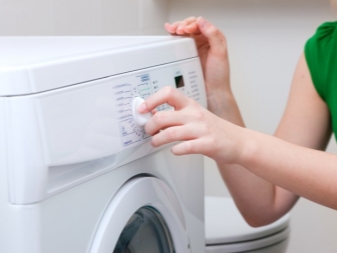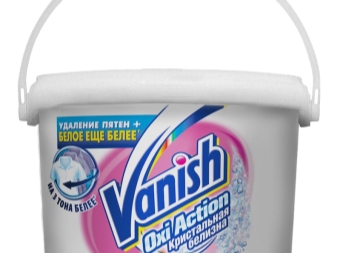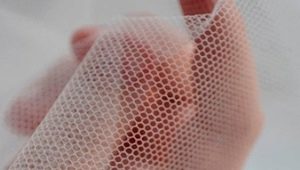How to whiten tulle at home?

An integral part of the set of modern interiors is tulle. With the use of this product the room becomes more cozy and comfortable. But for sewing tulle often used capricious materials that need regular and thrifty care. Today there are a large number of proven methods that will help you in this matter.
Is it possible to lighten?
Most often polluted classical tulle in light colors. Therefore, most people wonder whether it is possible to whiten a product qualitatively at home. Even the most fastidious materials can be carefully and quickly get rid of stains, but in this case it is important to choose the appropriate method.
Currently, the most common are models made of organza and nylon.
The first type refers to the capricious materials, so the cleaning should be taken very seriously. Particularly popular are white models, which are often amenable to contamination. For a start it is worth saying that the organza does not tolerate contact with hot water.
In order to become a snow-white tulle, you must use brine. Effectively remove strong stains will help brilliant greenadded to the liquid.
But the processing of nylon will take quite a long time. This synthetic material needs careful delicate cleaning. Fortunately, there are many ways that can give the fabric the same whiteness. For cleaning, you can use the same salt and brilliant green.
From yellowness
The hardest thing to whiten the yellowed curtain, which has long lost its original appearance. But modern housewives offer several effective ways to solve this problem, and one of the most effective is the use of green stuff. Basically, it is used to prepare the solution.
Tulle should be carefully washed in water (250 ml) with brilliant green (10 drops). Before soaking the product, it is necessary to see if sediment has appeared. In the presence of brilliant green at the bottom, the liquid must be stirred until completely dissolved, so that stains will not form on the fabric. In the finished mixture dip tulle and leave for 5 minutes.
Often the yellowness on tulle appears from the sun, mainly in the summer.
To whiten the material is quite simple: you need to soak it in water with powder. The product is left for 2 hours, then rinsed in water. If there is additional contamination, you can add salt.
From dullness
To return the former look to the grayed material will help common potassium permanganate. It is worth noting that people use this method for quite a long time. Basically, the solution of manganese is suitable for whitening nylon.
To prepare the mixture you need to take the soap (150 g) and potassium permanganate. Normal water is used to dissolve the product.
In order to make a solution, the pelvis must be filled with water. Soap rubbed on a grater, then add liquid. The solution must be thoroughly stirred to make it homogeneous.Then potassium permanganate diluted with a small amount of liquid. Stir the mixture when precipitate forms.
After that, the solution is poured into the pelvis. The mixture should have a soft pink hue. Also on its surface a small foam from soap is formed. Pre-washed tulle is left in the solution for 25-30 minutes. Curtain rinsed and hung to dry.
It is worth noting that the result after applying this method is maintained for a long time.
If there was no potassium carbonate on hand, a simple soap solution will help to return the former beauty of tulle. It is brought to a boil, then cold water is added to it. It is worth noting that this method also allows you to get rid of yellowness.
Materials
As noted above, organza and nylon are most often used to create tulle. This is due to the fact that these fabrics have a good appearance, their products fit perfectly in almost all interiors. But the disadvantage is that the materials quickly get dirty and lose their original appearance under the influence of many factors.
For example, to clean nylon tulle will help not only brilliant green, but also starch. Also this product is suitable for products from organza. To prepare the solution requires starch (250 g) and pure warm water. Tulle should be left in the pelvis with the contents for a few minutes.
Often, to create products used chiffon. Beautiful flowing material favorably complements the interior of any bedroom. The peculiarity of the fabric lies in the small thickness of the filaments, and because of this, chiffon tulle is not very durable. Most commonly, salt added to cold water is used to bleach textiles.
Another common and beautiful material at the same time is the veil. Thick mesh, supplemented with linen weaving provides a presentable appearance to home textiles. Voile tulle is quite easy to damage, especially in the washing process. That is why it is recommended to clean the material by hand with blue or starch.
But removing dirt from synthetic nylon tulle will help a mixture of baking soda and lemon juice. This tool does an excellent job with stubborn stains. In addition, the fabric is not deformed during processing.
In comparison with the previous types, cotton products are less whimsical. For their cleaning is used boiling with the addition of soap. Also to remove stains you can apply peroxide and ammonia solution. A good bleaching option would be a starch blend.
Hydrogen peroxide
Often, ordinary hydrogen peroxide is used to whiten tulle at home. Most often it is used together with ammonia.
Hydrogen peroxide is mainly used for bleaching cotton materials. Also with this tool you can easily bleach nylon, silk and polyester.
So, to prepare the solution, you will need warm water (10 l) and peroxide 3% (60 ml). To these components you need to add ammonia (25 ml). Tulle should be immersed in a basin with a solution for about 30-40 minutes. Take care that the material does not rise above the liquid, otherwise yellow stains will form on this surface.
It is worth noting that hydrogen peroxide is often used for machine processing of products. The tool must be added to the powder.Before washing, 10 tablets of hydroperit are poured into the compartment. The optimum temperature is 40 degrees. Spin mode is not required.
Salt
Often, modern housewives use table salt to clean the tulle curtains. This product is present in every home, and therefore if there were no means at hand, you can safely apply this option.
Table salt must be used to prepare the solution. 1.2 kg of product are dissolved in warm water, after which laundry detergent is added to the components. Textiles should be left in the basin with water for 9-10 hours until the spots completely dissolve. It should be noted that it is possible to wash tulle both manually and with the help of a machine. In the second case, spinning is not required.
Often saline solution is used for normal rinsing. You can also whiten and starch the material with a mixture of salt and water. Often the solution is used for processing textiles in the nursery, as the product is not among the allergens.
Ammonia
For bleaching home textiles, ammonia and peroxide are often used. The method of preparation of the solution was described above.But there is a so-called “night bleaching method”. In water, you need to add a bottle of ammonia, and then immerse the product in a basin with a solution. In the morning, the fabric should be thoroughly rinsed and hung to dry.
Blue sign
Eliminate dirt and stained spots from tulle will help bluing. Before applying the solution, the material must be carefully washed.
It should be noted that the blue is used for both manual processing and machine.
In the first case, it is necessary to dilute 1 tsp. means in 8 l of warm water. Carefully follow to avoid lumps. Otherwise stains will remain on the fabric.
Then the tulle should be thoroughly rinsed in blue and clean water. The manual method is applied to whimsical materials that do not tolerate the washing machine.
As for machine processing, the process is somewhat simpler. Blueprint is used instead of air conditioning. In the compartment you need to fill 1 cap.
The advantage of this method is that the whitening does not take much time. Blueprint returns to tulle the original look, the fabric becomes clean and snow-white.
As for the cons, they are also available.Many housewives argue that finding such a tool in the stores is almost impossible.
In addition, if it is bad to stir the powder during the preparation of the solution, traces may remain on the material. It is worth noting that blue stain spots are not displayed. That is why it is recommended to wash the curtains by hand, as the machine is not always able to completely dissolve the bleaching agent.
Baking soda
Regular soda that is available in every home will help to return the original look to white tulle. To prepare the solution will need 1 tbsp. l This tool and a small amount of washing powder. The ingredients are diluted in 5 liters of water.
Curtains should be soaked in a solution and leave for about 20 minutes. After the tulle is washed and rinsed thoroughly. With this solution, you can quickly and easily whiten the yellowed curtain. It should be noted that most often the method with soda is used for washing curtains that hang in the kitchen. The tool perfectly removes fat stains and removes unpleasant odors.
It should be noted that soda ash is often used instead of bleach.
Means is ideal for digestion. The process itself is not complicated and consists of the following steps:
- cold water, pre-rubbed soap and powder are poured into the container;
- a small amount of soda ash is introduced into the base;
- water is stirred until the soap and powder are completely dissolved;
- the tissue is placed in the solution.
Then the water must be brought to a boil. The solution needs to be stirred frequently, which will enhance the effect of bleaching. After that, you need to turn down the heat and leave the tulle to languish for an hour. After this time, the fabric is rinsed, slightly squeezed and hung out to dry.
Citric acid
You can return the original whiteness of the tulle with the help of regular citric acid. This tool will be found in every home, and therefore there will not be any special problems with the solution preparation process.
So, the material is washed with laundry soap in order to eliminate stubborn stains. Tulle is soaked in hot water for 30 minutes. If you notice that there are fatty spots or burning traces on the fabric, add a small amount of peroxide to the basin.
Then the product must be thoroughly rinsed in warm water using a bag of citric acid.
In the washing machine
Wash white tulle and you can use a washing machine. The process itself requires a minimum amount of time and effort, but when processing delicate fabrics it is necessary to take into account some features.
Basically, before you start washing in a typewriter, the tulle is cleaned manually. This will help remove stubborn stains and dirt. Pay attention to the purity of the drum and check the inside of the machine for the presence of forgotten colored things that might remain after the previous cycle.
White tulle made from a fabric like organza or nylon is recommended to be placed in a special bag. This will help to avoid damage to the material during the washing process.
Also in the machine you need to set the "delicate" mode. Basically, a temperature of 40 degrees is suitable for tulle.
As for the means for washing, it is better to use special oxygen bleach. Often, the standard food baking powder is used to return the product to its original appearance and past freshness. A bag of product is mixed with 1 tbsp. l baking soda. If this ingredient was not at hand, you can use salt.
All components fall asleep in the powder compartment.Instead of a delicate wash, you can install a manual processing program. When using these components, the water temperature should be 30 degrees.
To wash the tulle well, you must set the rinsing mode. It is best for this treatment to be repeated 2 times.
Useful recommendations
If for the first time you are engaged in the bleaching of tulle at home, you can use some useful recommendations from experienced housewives. To begin with, it is worth saying that after removing the tulle from the eaves, it is necessary to shake it out carefully, but not at home. This will help get rid of dust.
It is recommended to soak old soiled curtains before washing overnight. Products must be immersed in water with powder. Thanks to this, even the stale spots will quickly soften.
In order for tulle to become white, it is necessary to use water with a temperature of no more than 40 degrees. This is especially true for products that have turned yellow. If the water is hot, the dirt will be permanently absorbed into the fabric fibers.
If you erase delicate materials by hand, never rub them, otherwise they will be damaged.
Often used to wash the tulle chemical bleach, which quickly remove even the most powerful spots. The advantage of these options is that the process of removing pollution does not take much time and effort. But before using these tools it is recommended to study the instructions in detail. It is also necessary to properly observe the precautions when working with chemical bleach.
Basically, these tools are used simultaneously with washing powders. Bleaches fall asleep in the machine compartment. Also, tulle can be soaked separately with the tool for 20 minutes.
Often modern housewives use the popular stain remover Vanish. It should be noted that the tool processes only those areas where there are traces of dirt. According to customer reviews, this significantly reduces the cost of expensive funds. In addition, the stain remover provides a pleasant aroma to the washed product. Due to this there is no need for additional rinsing.
As for the method of application, it is not very complex. In warm water you need to dissolve the required amount of stain remover.Dirty tulle is placed in the pelvis and left for 1 hour. With strong stubborn stains, it takes 3 hours. At the end of time, the tulle should be pulled out and rinsed.
In no case can you use stain removers with bleach. Aggressive substance has a negative effect on tissue fibers. Especially it concerns the burnt out products.
Often modern housewives are wondering about how to clean rust from tulle. Lemon juice, which is applied to the place of pollution, will help solve the problem. After processing it is necessary to iron the fabric through gauze or thin material. In most cases, the stain comes off the first time. If contamination remains, repeat the procedure.
But to get rid of the grayness and yellowness is possible not only with brilliant green. Often used for these purposes aspirin, which is diluted in water. In 5 liters of warm water, add 4 tablets. The fabric is soaked for 20-30 minutes, then rinsed.
How beautifully to hang up already bleached tulle in kitchen, look in the following video.
